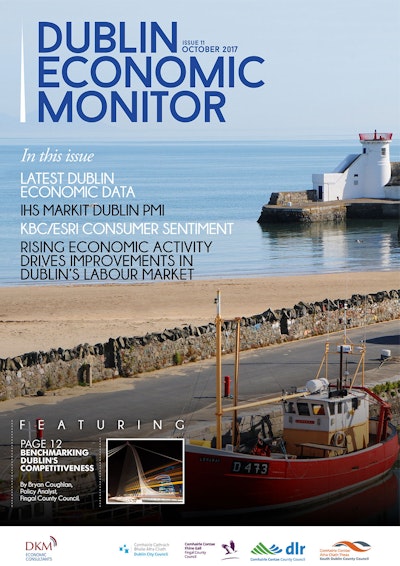The eleventh issue of the Dublin Economic Monitor has been launched today. A joint initiative of the four Dublin local authorities, the Monitor focuses on the Dublin region, and tracks 15 key economic indicators.
It captures data from the height of the boom to the economic crash and the subsequent recovery. These indicators show that Dublin’s labour market continues to improve, with a rebound in the construction sector central to expansions in business activity.
Key highlights:
- Dublin’s unemployment rate dipped to a 9-year low of 6.1% in Q2 2017.
- Residential rents in Dublin returned to strong levels of growth in Q2 2017 as average rents for houses and apartments reached new peaks.
- Residential property prices rose to a 9-year high with YoY growth rates exceeding 11% in both June and July.
- Public transport trips continued to grow strongly to reach a new peak of over 52 million passenger journeys in Q2 2017.
- Passenger arrivals at Dublin Airport maintained upward momentum in Q2 2017 on the back of greater connectivity to other international destinations.
- Housing completions in Dublin increased to over 540 in May 2017 and will be expected to rise further on the back of greater levels of housing commencements.
This issue of the Economic Monitor contains a special report by Bryan Coughlan of Fingal County Council on the strong competitiveness of the Irish and Dublin economies in an international context.
Lorcan Blake, Economic Consultant at DKM Economic Consultants said:
“It is evident that the Dublin economy has maintained its momentum in 2017 with the labour market showing particularly positive signs. Rising employment and tourism volumes have fed through to many aspects of the economy, including both Dublin Airport and the public transport system where passenger journeys continue to increase at strong rates.”
Austin Hughes, Chief Economist at KBC Bank Ireland said:
“Dublin consumer sentiment saw a strong improvement as the persistence of healthy trends in activity and employment eased earlier fears of a sharp Brexit related slowdown. This increased confidence was also reflected in a marked upgrade of the buying climate by Dublin consumers that should help underpin consumer spending in the capital.”
Andrew Harker, Senior Economist at IHS Markit said:
“The Dublin private sector economy continued to grow strongly during the third quarter of 2017, supported by sharp rises in new work. There was a welcome pick-up in the rate of job creation following a slowdown in Q2, with firms increasingly willing to take on extra staff in line with higher workloads. The capital’s economy, therefore, looks in good shape to end the year on a positive note. All three monitored sectors saw output expand, with the construction sector again the best performer. Growth outside of Dublin also remained strong in Q3, highlighting the broad-based nature of the current upturn.”
Register at the following link for quarterly updates on Dublin’s economic performance.
All figures are seasonally adjusted


